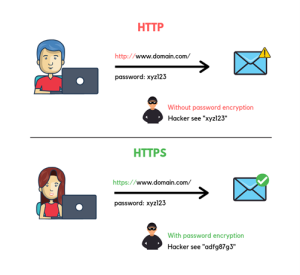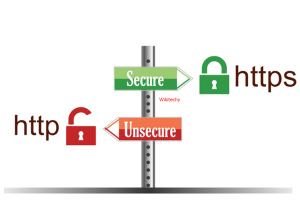Introduction:

In web communication, the choice between HTTP (Hypertext Transfer Protocol) and HTTPS (Hypertext Transfer Protocol Secure) plays a pivotal role in determining the security and integrity of data transmission. These protocols dictate how information is exchanged between a web server and a browser, but they differ significantly in terms of security measures. Let’s delve into the nuances of HTTP and HTTPS to understand their disparities and why opting for HTTPS is crucial in today’s digital landscape.
Protocol Type Used Between HTTP and HTTPS:
HTTP operates as a plain-text protocol, making it susceptible to interception and manipulation by malicious actors. Conversely, HTTPS employs encryption mechanisms, safeguarding data from unauthorized access during transit. The “S” in HTTPS stands for “Secure”, indicating the enhanced security features it offers over HTTP.
Security:
One of the most glaring distinctions between HTTP and HTTPS lies in their approach to security. HTTP lacks encryption, exposing transmitted data to potential eavesdropping and tampering. On the contrary, HTTPS utilizes SSL/TLS (Secure Sockets Layer/Transport Layer Security) encryption protocols, ensuring that data remains confidential and integral throughout its journey between the server and the client.
Port:
HTTP typically operates on port 80, while HTTPS utilizes port 443 by default. This differentiation in ports allows servers to distinguish between regular HTTP traffic and encrypted HTTPS connections seamlessly.
Encryption:
HTTP sends data in plaintext, rendering it vulnerable to interception. In contrast, HTTPS encrypts data using SSL/TLS protocols, rendering it unreadable to unauthorized parties. This encryption mechanism is essential for protecting sensitive information such as login credentials, financial transactions, and personal details.

Data Integrity:
With HTTP, data integrity is not guaranteed, as the absence of encryption leaves it susceptible to alteration during transmission. On the other hand, HTTPS ensures data integrity by employing cryptographic algorithms to detect any unauthorized modifications, thus maintaining the integrity of the transmitted information.
Certificate:
For HTTPS to function, websites require an SSL/TLS certificate issued by a trusted Certificate Authority (CA). This certificate serves as a digital credential that verifies the authenticity of the website and establishes a secure connection with the client’s browser. In contrast, HTTP does not necessitate the use of SSL/TLS certificates, making it inherently less secure.
URL:
The URL of a website indicates its protocol: HTTP or HTTPS. HTTP URLs begin with “http://” whereas HTTPS URLs start with “https://”. This visible distinction allows users to identify whether a website is employing a secure connection or not, thereby influencing their trust and confidence in the site’s security measures.

Trust:
HTTPS instills greater trust and confidence among users due to its robust security features. Websites that implement HTTPS are perceived as more reliable and trustworthy, as they prioritize the protection of user data. Conversely, HTTP connections are deemed less secure and may deter users from interacting with the website, particularly when sensitive information is involved.
Usage:
While HTTP suffices for transmitting non-sensitive data, HTTPS is indispensable for secure communication, especially when handling confidential information. E-commerce websites, banking portals, social media platforms, and any site dealing with user authentication or financial transactions must prioritize HTTPS to safeguard sensitive data and uphold user privacy.

http-vs-https
Feature |
HTTP |
HTTPS |
| Protocol Type | Unsecured | Secured |
| Security | Not encrypted, data sent in plaintext | Encrypted, data sent securely |
| Port | Default port is 80 | Default port is 443 |
| Encryption | No encryption used | Uses SSL/TLS encryption for data transmission |
| Data Integrity | Data may be vulnerable to interception and modification | Data is protected from interception and modification |
| Certificate | Not required | SSL/TLS certificate required for encryption |
| URL | Begins with “http://” | Begins with “https://” |
| Trust | Less secure, prone to attacks | More secure, less vulnerable to attacks |
| Usage | Suitable for non-sensitive data transmission | Essential for secure data transmission, especially for sensitive information |
These are the primary differences between HTTP and HTTPS, with HTTPS being the more secure option due to encryption and data integrity measures.
Conclusion:
In conclusion, the choice between HTTP and HTTPS significantly impacts the security, integrity, and trustworthiness of online communication. As cyber threats continue to proliferate, embracing HTTPS as the standard protocol for web communication is imperative. By encrypting data, ensuring its integrity, and bolstering user trust, HTTPS serves as a cornerstone of modern cybersecurity. Gain expertise in networking with Kaashiv Infotech courses and internships. Learn about port security and functionality, essential for protecting data. Whether a beginner or seasoned professional, Kaashiv Infotech offers tailored programs for all skill levels. Elevate your career with practical learning and industry exposure.
